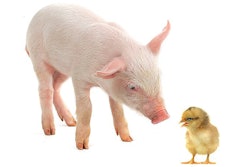
Bacteria found in kangaroos could trigger long-lasting reduction in emissions from cattle, study says
A particular blend of bacteria found in the hindgut of kangaroos could provide a long-lasting solution to methane emissions from cattle, according to a new study out of Washington State University.
Enteric methane emissions from cattle are produced by bacteria called methanogens, microorganisms that eat hydrogen and carbon dioxide in the rumen and release methane. The hydrogen has to go somewhere — too much hydrogen in the rumen will cause upset, according to Birgitte Ahring, a professor of bioengineering at Washington State University. But if you could replace the methanogens with another type of bacteria that also eat hydrogen, Ahring said, you might be able to reduce enteric emissions for extended periods of time.
It was while looking for such a microorganism that Ahring’s team encountered kangaroos — or more specifically, research describing the microbiome of the kangaroo hindgut.
The microbiome associated with baby kangaroos in particular does not contain methanogens, Ahring said. And there happened to be a handful of kangaroos at petting zoos near the Washington State University laboratory where she works. So the team collected a handful of samples to test in an artificial rumen simulator.
So far, Ahring said, the results are very promising. Multiple trials have shown that the kangaroo bacteria can overtake and outnumber methanogens for two to three months, eliminating hydrogen from the rumen while reducing methane emissions during this time.
If the culture performs as expected in live animals — Ahring’s team is working to coordinate live animal trials that could begin this year — the kangaroo bacteria could be added to feed as essentially a probiotic. The bacterial culture can be grown in a lab, so you don’t need access to actual kangaroos to make the probiotic. And unlike existing emissions solutions like 3-NOP or the seaweed asparagopsis, it wouldn’t need to be constantly added to feed formulations. A single dose every other month should do the trick. Or, Ahring said, the probiotic product could be used in tandem with other solutions for potentially greater emissions reductions.
The kangaroo probiotic might also benefit cattle production, Ahring said, because the bacteria contained within the culture produce acetic acid in place of methane. Acetic acid is taken up in the bloodstream as, essentially, a precursor to meat production, though more research will be necessary to determine what effect the probiotic culture might have on cattle.
“It’s a very interesting concept and worth testing on real animals,” Ahring said.













